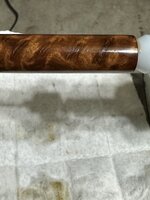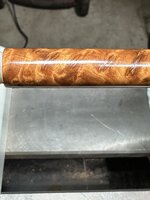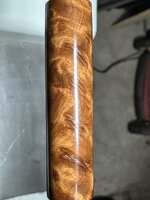jschoolcraft
Member
I showed off this pen in Burls really steal the show. So as not to bury the lead: after a week or so of sitting in my office the tube felt a bit sticky and there were cracks on some of the swirls in the burl:
[EDIT: Must have used a private image]



This is a picture after I disassembled the pen and put it back on the lathe. I'm not sure what happened. More importantly I'm not sure if this is a one off thing or how I can prevent it in the future.
I'll include the original pen image at the end but it came off the lathe silky smooth and I've been finishing all my pens the same way for the last month or so:
I haven't applied Renaissance Wax since switching from Mylands Friction Polish to Pens Plus.
This is my only pen, that I know of, that has done this.
Original pen post:

[EDIT: Must have used a private image]



This is a picture after I disassembled the pen and put it back on the lathe. I'm not sure what happened. More importantly I'm not sure if this is a one off thing or how I can prevent it in the future.
I'll include the original pen image at the end but it came off the lathe silky smooth and I've been finishing all my pens the same way for the last month or so:
- Sand through the grits (120 - 600)
- Wipe down with alcohol (isopropyl. I don't have denatured and haven't tried to find everclear or similar)
- Apply Mylands sanding sealer
- Use Yorkshire Grit abrasive paste
- Apply 3-4 coats of Doctor's Workshop Pens Plus (applied at 100s RPM, then friction at 2500-3000 RPM, let it cool down for a few minutes between applications)
I haven't applied Renaissance Wax since switching from Mylands Friction Polish to Pens Plus.
This is my only pen, that I know of, that has done this.
Original pen post:
Last edited:
